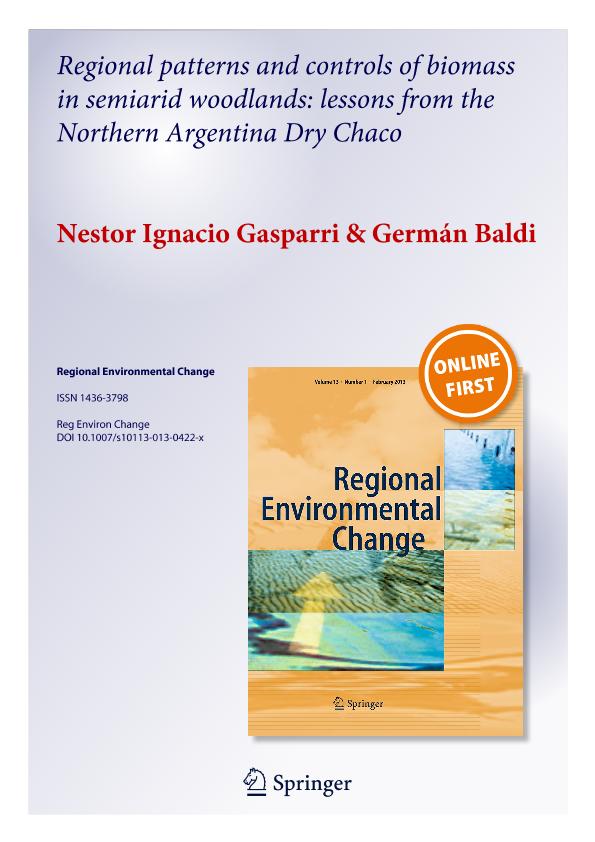Mostrar el registro sencillo del ítem
dc.contributor.author
Gasparri, Nestor Ignacio

dc.contributor.author
Baldi, Germán

dc.date.available
2015-07-07T15:01:14Z
dc.date.issued
2013-02
dc.identifier.citation
Gasparri, Nestor Ignacio; Baldi, Germán; Regional patterns and controls of biomass in semiarid woodlands: lessons from the Northern Argentina Dry Chaco; Springer Heidelberg; Regional Environmental Change; 6; 2-2013; 1131-1144
dc.identifier.issn
1436-3798
dc.identifier.uri
http://hdl.handle.net/11336/1073
dc.description.abstract
Land use change, particularly in forested ecosystems,has a direct impact on the global carbon cycle. Consequently, the regional assessment of biomass and the understanding of its current spatial controls are research priorities for regional ecology and land use. Field data and satellite imagery were combined here to map woodlands and estimate their above-ground biomass (AGB) in the Dry Chaco ecoregion of northern Argentina. Allometric equations were used to derive AGB from diameter at breast height data collected at 50 samples during 2007. In order to generate the AGB regional map, this information was later associated with MODIS-Terra spectral data (NDVI) using the Random Forest (RF) method. Finally, AGB spatial patterns were associated with potential biophysical and human controlling factors through correlation and regression analyses. Results indicate that the use of RF and NDVI of the dry season derived from MODIS-Terra was suitable to map regional AGB, what makes this methodology applicable to other dry woodlands. The RF model used to map AGB showed a mean deviation of 2.9 % and a precision of 15 % for one prediction. At this regional scale of analysis, biophysical rather than human factors controlled AGB spatial patterns, in part because the region includes a wide range of environmental situations. Warmer conditions showed a higher biomass, suggesting an energetic limitation for AGB accumulation. However, human controls (distance to towns, cultivation, and roads) also conditioned AGB patterns, suggesting lower AGB values near cultivated areas. The relation between AGB and water availability was surprisingly weak, but partially obscured by the land use history and degradation due to extensive cattle ranching. We propose that a combination of environmental factor and land use affects the AGB regional patterns and promotes unexpected relationships with environmental factors. This work represents the first spatially explicit AGB (patterns and controls) analysis for an extensive subtropical dry woodland area (113,000 km2) and shows how biophysical and human factors co-control regional patterns.
dc.format
application/pdf
dc.language.iso
eng
dc.publisher
Springer Heidelberg

dc.rights
info:eu-repo/semantics/openAccess
dc.rights.uri
https://creativecommons.org/licenses/by-nc-sa/2.5/ar/
dc.subject
Subtropical Dry Woodlands
dc.subject
Above-Ground Biomass
dc.subject
Forest Degradation
dc.subject
Land Use
dc.subject
Random Forest
dc.subject
Remote Sensing
dc.subject.classification
Otras Agricultura, Silvicultura y Pesca

dc.subject.classification
Agricultura, Silvicultura y Pesca

dc.subject.classification
CIENCIAS AGRÍCOLAS

dc.subject.classification
Geografía Física

dc.subject.classification
Ciencias de la Tierra y relacionadas con el Medio Ambiente

dc.subject.classification
CIENCIAS NATURALES Y EXACTAS

dc.title
Regional patterns and controls of biomass in semiarid woodlands: lessons from the Northern Argentina Dry Chaco
dc.type
info:eu-repo/semantics/article
dc.type
info:ar-repo/semantics/artículo
dc.type
info:eu-repo/semantics/publishedVersion
dc.date.updated
2016-03-30 10:35:44.97925-03
dc.journal.volume
6
dc.journal.pagination
1131-1144
dc.journal.pais
Alemania

dc.journal.ciudad
Heidelberg
dc.description.fil
Fil: Gasparri, Nestor Ignacio. Universidad Nacional de Tucumán. Instituto de Ecología Regional. Consejo Nacional de Investigaciones Científicas y Técnicas. Centro Científico Tecnológico Conicet - Tucumán. Instituto de Ecología Regional; Argentina
dc.description.fil
Fil: Baldi, Germán. Consejo Nacional de Investigaciones Científicas y Técnicas. Centro Científico Tecnológico Conicet - San Luis. Instituto de Matemática Aplicada de San Luis "Prof. Ezio Marchi". Universidad Nacional de San Luis. Facultad de Ciencias Físico, Matemáticas y Naturales. Instituto de Matemática Aplicada de San Luis "Prof. Ezio Marchi"; Argentina
dc.journal.title
Regional Environmental Change

dc.relation.alternativeid
info:eu-repo/semantics/altIdentifier/doi/http://dx.doi.org/10.1007/s10113-013-0422-x
Archivos asociados
